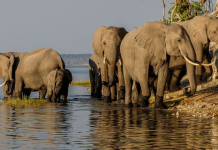The African bush elephant (Loxodonta africana) likely makes home in a wide variety of habitats of sub-Saharan Africa. The African bush elephant habitat includes grasslands, plains, oceanic beaches, thick forests, woodlands, semi-arid deserts, tree savanna, forest margins, evergreen rainforests, montane forests, lowland forests, floodplains, low-lying plains, upland moors, open and closed savanna, semi-deciduous forest, and mountain slopes. While the African elephants’ population is generally on the declining trend their habitats largely occur from sea levels to high mountains.
The African bush elephant makes habitat in grasslands, plains, oceanic beaches, thick forests, woodlands, and semi-arid deserts.
African bush elephants do not stay at one place. They will travel great distances in search of a suitable habitat and diet. African elephants live in large herds each of which is usually led by the oldest female. The oldest female is called Matriarch. African bush elephants are pure herbivores and they fancy choosing grasslands and forests that are especially abundant in shrubbery leaves and herbs.
References
Eltringham, S.K., ed. The Illustrated Encyclopaedia of Elephants. New York: Crescent Books, 1991.
Maglio, Vincent J. “Origin and Evolution of the Elephantidae.” Transactions of the American Philosophical Society 63, no. 2 (1973): 1–149.






